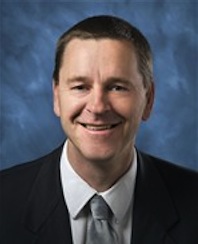Study advances treatment of respiratory failure in ALS patients
Amyotrophic lateral sclerosis (ALS), also known as Lou Gehrig’s disease, is a devastating neurological disorder with few effective treatments and no known cure. The most frequent cause of death in ALS patients is breathing failure because, as the disease progresses, it kills the nerve cells that cause the respiratory muscle to contract.

Mitchell
A new study, published online in the American Journal of Respiratory and Critical Care Medicine and conducted largely at the University of Wisconsin–Madison, shows the potential for two complimentary treatments — stem cell therapy and intermittent exposure to low oxygen — to preserve and even restore breathing capacity in rats with a condition similar to ALS in humans.
“This study represents a convergence of two different approaches that we think will be mutually reinforcing,” says Gordon Mitchell, professor of comparative biosciences at the UW School of Veterinary Medicine and co-principal investigator for the study.
ALS causes paralysis by killing motor neurons, the nerve cells that send electrical impulses from the spinal cord to the muscles to produce movement. When the disease attacks the phrenic nerves, which carry information to the diaphragm — the respiratory muscle essential to breathing — the dying motor neurons stop sending signals. This degeneration leads to death from respiratory failure.

Svendsen
The researchers tested the potential of two treatments for addressing this problem in laboratory rats in the end stage of ALS and found very promising results. One part of the study, conducted by a team led by Clive Svendsen, now director of the Regenerative Medicine Institute at the Cedars-Sinai Medical Center in Los Angeles, used human neural progenitor stem cell transplants to repair the environment around the phrenic motor neurons. Although the treatments did not replace dying neurons, they slowed the rate at which the cells died and helped preserve breathing function.
“The human stem cells migrated toward areas of damage and restored respiratory output,” says Svendsen, whose team conducted the bulk of the work on the UW–Madison campus while he was co-director of the UW Stem Cell and Regenerative Medicine Center. “They seem to act as support or nursing cells that prevent the neurons from dying.”
For the second part of the study, Mitchell and his team tested the effects of a novel low-oxygen treatment on the ability of surviving motor neurons to generate breathing. Acute intermittent hypoxia (AIH) delivers intervals of air containing nondamaging low oxygen levels to trigger a response that strengthens the motor neuron signals. AIH can help stimulate function in muscles associated with breathing and limbs and has been applied successfully to spinal injury cases in humans. In this study, the method restored the function of phrenic nerves in the rats to normal levels, helping to restore the ability to breathe.
“There is no cure for ALS, and it is invariably fatal, so any progress is a major advance.”
Gordon Mitchell
“Together, the findings tell us that these two treatments have complementary translational potential to treat breathing deficits in ALS patients,” says Mitchell.
Mitchell says the study, which was funded by the National Institutes of Health and the ALS Association, is unusual because most ALS research and experimental treatments target the loss of function in patients’ limbs, which does not address the most common cause of mortality in ALS patients. “There is no therapy that is going to prolong their lives unless it also improves breathing,” he says.
According to Svendsen, the findings have informed other work that has wider implications for humans. Mitchell is currently involved in studies using a similar AIH method to help improve leg strength and walking in patients with mild spinal cord injuries. In addition, the California Institute for Regenerative Medicine has provided Svendsen with funding to design and carry out a trial in humans that uses similar stem cells in ALS patients, although this particular study will also focus on lower spinal cord and leg function.
“There is no cure for ALS, and it is invariably fatal, so any progress is a major advance,” says Mitchell.
—Nik Hawkins




